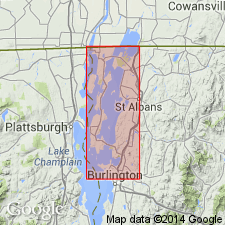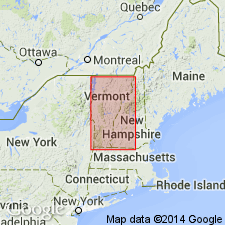
- Usage in publication:
-
- Hathaway formation
- Modifications:
-
- Named
- Dominant lithology:
-
- Breccia
- Argillite
- Chert
- Sandstone
- Graywacke
- Dolomite
- Limestone
- AAPG geologic province:
-
- New England province
Summary:
Named the Hathaway formation for Hathaway Point on St. Albans Point, Franklin Co., VT. Consists of argillite and bedded radiolarian cherts, commonly intensely deformed, with small fragments to large blocks of quartz sandstone, coarse graywacke, dolomite, limestone, and chert. Unit considered a submarine slide breccia. Thickness is more that 100 feet. Also well exposed on several nearby islands in Lake Champlain. Overlies the Iberville formation. The Hathaway is of Middle Ordovician age.
Source: GNU records (USGS DDS-6; Reston GNULEX).

- Usage in publication:
-
- Hathaway formation
- Modifications:
-
- Revised
- AAPG geologic province:
-
- New England province
Summary:
The Hathaway formation is included in the Trenton group in the Champlain and Vermont Valleys of VT. Consists of gray to black argillite and bedded radiolarian chert, with included blocks and fragments of chert, limestone, dolomite, and graywacke.
Source: GNU records (USGS DDS-6; Reston GNULEX).
For more information, please contact Nancy Stamm, Geologic Names Committee Secretary.
Asterisk (*) indicates published by U.S. Geological Survey authors.
"No current usage" (†) implies that a name has been abandoned or has fallen into disuse. Former usage and, if known, replacement name given in parentheses ( ).
Slash (/) indicates name conflicts with nomenclatural guidelines (CSN, 1933; ACSN, 1961, 1970; NACSN, 1983, 2005, 2021). May be explained within brackets ([ ]).

